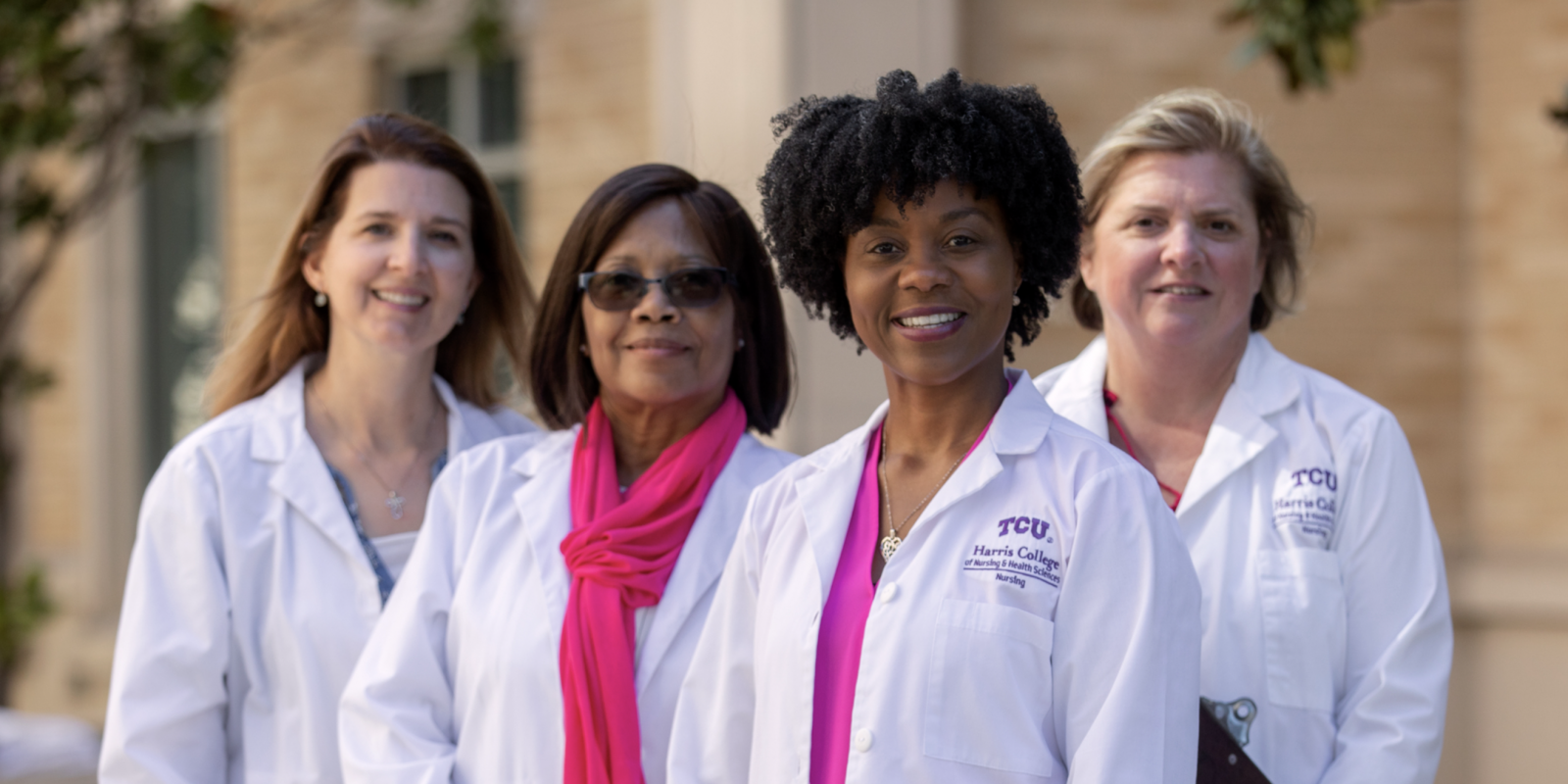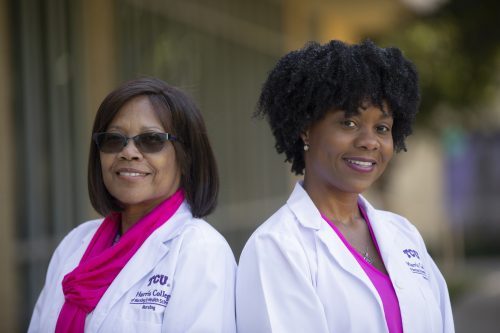
Janie Robinson (front) studies disparities in health care, focusing on how race influences outcomes related to kidney health. From left to right in the background are fellow TCU nursing faculty members Gina Alexander, Glenda Daniels and Lori Borchers.
Prescriptions for Chronic Inequities
TCU researchers seek to close gaps in health care access and outcomes for underserved people.
UNEQUAL HEALTH CARE COSTS AMERICAN LIVES. A three-year study published in 2021 by the American Medical Association revealed that the deaths of more than 74,000 Black Americans in 30 urban areas were a direct result of health care inequities.
That same year, the life expectancy of white people in the U.S. was 76.4 years, compared with 65.2 years for American Indians and Alaska Natives and 70.8 years for Black people.
Faculty across TCU’s Harris College of Nursing & Health Sciences are studying disparities in health care while working to increase health equity in Fort Worth, the surrounding communities and across the country.
“Disparities in health care outcomes are one of the biggest problems of health care in our society,” said Christopher Watts, the Marilyn and Morgan Davies Dean of Harris College of Nursing & Health Sciences. “We have gaps in different populations in the care they receive and the outcomes they obtain from care.”
TCU professors are harnessing their creativity to bridge those gaps.
“Most of the research done by our faculty is applied research,” Watts said. “Our faculty are going out into the community to help real patients, which aligns with our vision for transforming health care.”
Professors are addressing everything from kidney disease to childbirth with an eye toward improving the quality of life for underserved patient populations.
“Our faculty are a great example of TCU’s teacher-scholar model,” Watts said. “They’re asking new research questions, getting answers to those questions and bringing this information immediately and directly back into the classroom while also improving the health of our communities.”
Knowledge Guides
Janie Robinson became interested in kidney health while working nights in a hospital’s telemetry unit. She saw firsthand what a study from the National Institute of Diabetes and Digestive and Kidney Diseases concluded: Though only 13 percent of the U.S. population, Black people account for 35 percent of people with kidney failure.
Research from the National Institutes of Health reveals that Black Americans are four times more likely than white Americans to develop kidney failure in their lifetime.

Catherine Falls Commercial | Moment | Getty Images
On her nursing shifts, Robinson, now a professor of nursing, witnessed the Sunday night increase in Black men who needed emergency dialysis.
“When your kidneys fail, everything that you drink stays in your body,” Robinson said. “The excess fluid builds up, causing the heart and lungs to fill up and not function properly.” In addition, kidneys remove waste from the body, which is also crucial to sustaining life.
Symptoms of failing kidneys include itchy skin, muscle cramps, nausea and swelling of the hands, legs or feet.
“If the fluid and excess waste are not removed, the person can die,” Robinson said, noting that hemodialysis pulls the excess fluid and waste from the body during sessions that typically run four to five hours.
Those experiences became the basis of Robinson’s career-spanning work at the intersection of kidney failure and health knowledge in the Black community. She has interviewed hundreds of people to understand their comprehension of factors that impact kidney health, including low-sodium diets, compliance in taking medications, financial difficulties and the physical/emotional toll of the disease and its treatment.
“Diabetes and high blood pressure are the leading cause of kidney disease,” she said, “and African Americans tend to experience both of these disparities, making the chance of kidney disease greater.”
Prevention starts with education, including helping patients understand the function and the importance of kidneys.
They also need to know “how to protect the kidneys by regular checkups with essential labs and blood-pressure screening,” she said. Diet and exercise are key, too, as is taking medications as prescribed.
Robinson partnered with Glenda Daniels, professor of nursing, for a study at a Fort Worth barbershop, the Faded Blue Lounge. They recruited 100 Black men to assess their knowledge about kidney disease using questionnaires. MEDSURG Nursing published their findings in the January-February 2022 issue.
The professors chose this population in large part because Black men are statistically among the most likely to have blood pressure problems and the least likely to receive annual wellness exams.
“It’s a health crisis,” Daniels said. “In our first study we were looking at the lived experience of African Americans who were already on hemodialysis, but then we decided to start at the beginning to try to find ways to prevent kidney disease from progressing to the final stage of complete kidney failure.”
They gravitated to the barbershop venue “because it’s a focal point of the African American community,” Daniels said. “Historically, barbershops offer individuals a chance to just come and talk and be themselves.”
After analyzing the data from the conversations, Daniels and Robinson gained a greater appreciation for the power of information.
Now, having assessed the participants’ knowledge, the professors plan to return to offer education to fill those gaps in knowledge and to provide health screenings.
Going Green
Gina Alexander, professor of nursing, wants people to disconnect from devices and head outdoors. Sedentary lifestyles can raise risks for health woes including cardiovascular disease and obesity.
Loneliness is another growing issue that communal outdoor spaces can help address. In May 2023, Surgeon General Dr. Vivek Murthy released a groundbreaking report on “Our Epidemic of Loneliness and Isolation.”
At the height of the Covid-19 pandemic, Alexander said, she became aware that in pockets of Fort Worth many residents found it difficult to utilize quality green spaces, which have proven health and stress-reducing benefits.
“Public health nursing, which I teach, is different from other specialties because it focuses on the population as a whole,” Alexander said. “Public health is about looking at the population on a macro level and then trying to do primary prevention as much as possible.”
Prescribing nature can improve an individual’s mental health, she said. To that end, Alexander helped create the program RxPLORE: Prescribing Life Outdoors and Real Exploration, which targets children, teens and families in low-income neighborhoods with the goal of initiating nature-based activities and community events.
Barriers for use of communal outdoor spaces can include a lack of transportation, proximity and the quality of the park, which includes factors such as safety. Some people, she discovered, avoid public parks because of homeless encampments and crime.
She has focused her efforts on Glenwood Park, a 37-acre green space in southeast Fort Worth in a neighborhood where many residents have limited resources. Alexander began exploring the most effective ways to encourage nearby residents to use the almost century-old park. In October 2022, she helped lead 46 TCU students and 37 community volunteers, some of them TCU alumni and faculty, to remove 9 tons of trash from the park.
Alexander also partnered with the Historic Southside Neighborhood Association and the Kids Environmental Education Network Group to lobby the city of Fort Worth for park upgrades. She and her allies advocated for new playground equipment, basketball hoops and a pedestrian bridge.
In response, the Fort Worth Park and Recreation Department has allocated $75,000 to develop a master plan, which will be implemented if approved by voters in a future bond election. Alexander’s advocacy will continue as she, her students and partners seek further input from community members and build citywide support for the plan.
“Getting people back to nature and investing in community is one of our themes in response to the loneliness and isolation that a lot of people felt during the pandemic,” said the former Tarrant County Public Health nurse. “Equity is really at the core of what we’re doing because we realize that it’s not easy for everybody to go outside and enjoy a quality green space.”
Diabetes and kids
Carol Howe studies racial disparities, diabetes and children.
Before coming to TCU, she worked as a pediatric nurse and diabetes care and education specialist at the Children’s Hospital of Philadelphia. During her doctoral program, she studied parent health literacy and how this might impact communication with diabetes educators.
Black, Hispanic and Native American populations experience significantly higher rates of diabetes than do white people.

Glenda Daniels (left) and Janie Robinson, associate professors of nursing, collaborated on a study of kidney disease awareness among Black men. Photo by Joyce Marshall
Per the U.S. Centers for Disease Control and Prevention, 8.7 percent of the U.S. population had some form of diabetes in 2019. The highest rate of prevalence occurred among American Indians and Alaska Natives at 14.5 percent. Non-Hispanic Black people and people of Hispanic origin saw rates close to 12 percent. The diabetes rate was 7.4 percent for non-Hispanic white people.
Diabetes management in children is no easy task. Parents must routinely test blood sugar and count carbohydrates while adjusting insulin levels based on food intake and activity. Puberty, growth spurts and even a common cold could change the equation at any given moment.
“Parents of all health literacy levels wanted to manage their child’s diabetes to keep them healthy,” Howe said. “But we found that low health-literate parents wanted concrete information on what they needed to do, and needed the information slowed down and repeated. They didn’t want us to give them too much at once and liked hands-on learning.”
On the other hand, parents with adequate health literacy wanted to understand how to critically think through daily decisions, such as how to manage a child’s weekend soccer tournament.
A recent study she spearheaded compared the differences between non-Hispanic Black and non-Hispanic white parents’ perceptions of diabetes technology, namely insulin pumps and continuous glucose monitors.
Her paper, published in February 2023 in The Science of Diabetes Self- Management and Care, presented findings from research conducted with 21 parents of children with diabetes.
From previous research, the team knew there were marked racial disparities in the use of insulin pumps and monitors in children with Type 1 diabetes, and they wanted to understand why from the parents’ perspective. What they discovered was “that in the Black community there’s been so much public health messaging around preventing diabetes in children — don’t let them drink sugary drinks, eat candy, get chips on the way home from school — that parents actually felt shamed by their community when their child was diagnosed with diabetes.”
As a result, they didn’t want to add to the stigma by asking their child to wear technology like an insulin pump, which would make the condition visible. Without an insulin pump and the monitoring tools, children must have blood sugar monitored by a finger stick before getting daily insulin shots.
The researchers also found that clinical teams used subjective rather than objective criteria for recommending insulin pumps and continuous glucose monitors to children and their caregivers.
Howe, who hopes her research will help health professionals develop guidelines and strategies to promote diabetes technology for families, is also advocating with Texas Medicaid to improve access to continuous glucose monitoring systems.
“We’re trying to ease the criteria to make access easier for people that use Medicaid insurance,” she said, “because there’s a lot of evidence about the health benefits of wearing a continuous glucose monitor.”
Immigrant Health
Published in July 2022 in the Journal of Transcultural Nursing, Njenga’s article “Somali Refugee Women’s Cultural Beliefs and Practices Around Pregnancy and Childbirth” examined the attitudes of expectant and new mothers to determine barriers to maternal health care and improve health outcomes.

Angela Njenga has found that a language barrier can complicate Somali mothers getting proper health care.
Diabetes, hypertension and access to health care, along with implicit bias and racism, all have the potential to contribute to tragic outcomes in Texas, the state with the 12th worst maternal mortality rate.
In the case of the Somali women, language barriers may make expectant mothers less likely to pursue prenatal care.
“Many of them did not understand the need for prenatal care if they weren’t sick,” she said. “They don’t necessarily understand the health care system here, wondering when and why they were supposed to go to the doctor and why they might need a particular medicine.”
Njenga’s research convinced her that health care professionals need to receive some form of cultural competency education before they work with pregnant Somalis.
“Doctors here often assume when they see a Somali woman that she’s been circumcised, which some of them had not,” she said. “But for those who had undergone female genital cutting, they’d feel objectified.”
One woman told Njenga that in the midst of a pelvic exam her doctor called for her colleagues to take a look at her altered anatomy, which made the patient “feel like an animal in an exhibit.”
Njenga’s ongoing work will focus on educating African immigrant mothers and the health care community.
Meanwhile, her colleagues will continue to innovate in the complementary arenas of research and patient care, part of the Harris College of Nursing & Health Sciences’ vision for transforming health care.
“For decades, our world-class faculty has conducted research in the community for the benefit of the community,” Watts said. “Our long and strong connections with Fort Worth and Tarrant County are leading to better health outcomes.”

Your comments are welcome
Comments
Related reading:
Research + Discovery
Deeper Compassion
Joe Hoyle’s capstone project examines the impact of empathy training on scuba volunteers.
Research + Discovery
History to Remember
A groundbreaking book from TCU Press tells a more complete version of the university’s past.
Research + Discovery
Lessons in Dyslexia
Caregivers learn strategies to help children build reading skills.